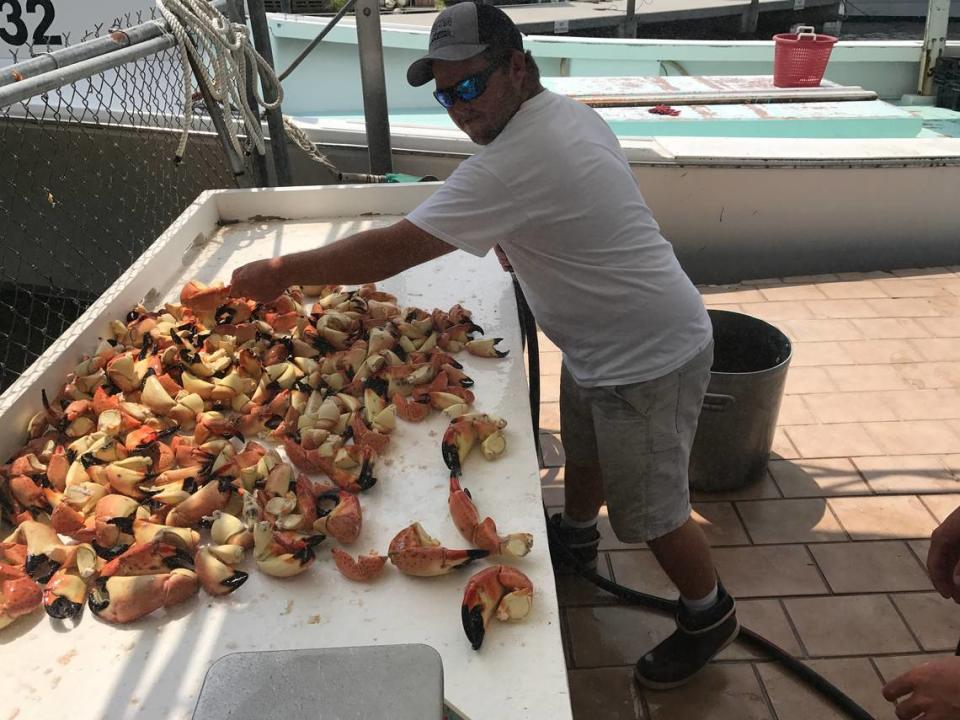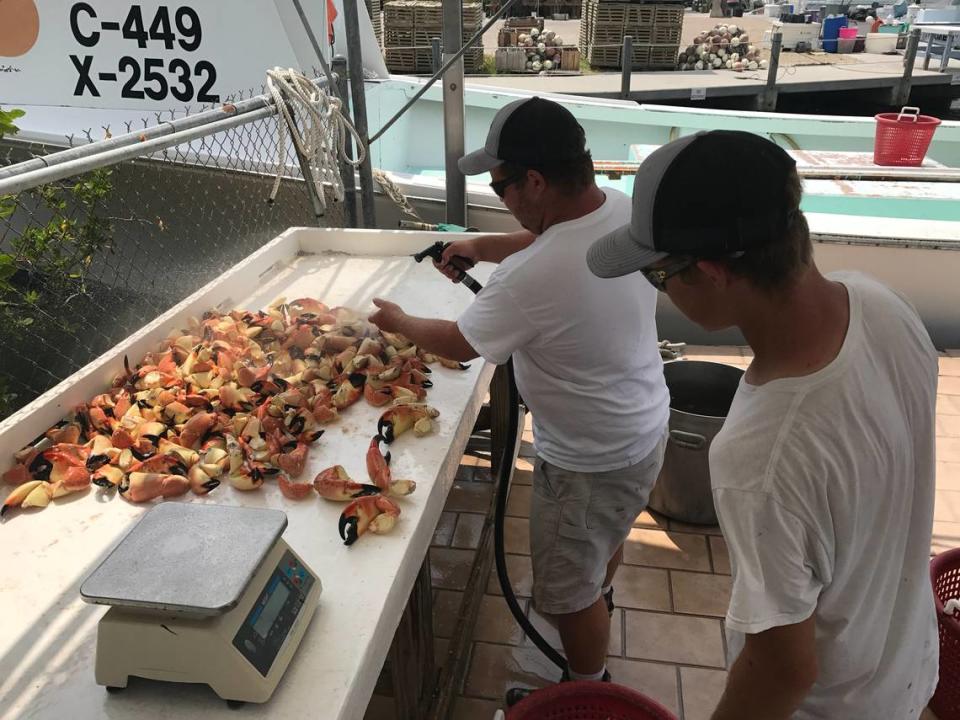First, a hurricane, Then, an algae bloom. Now, Keys fishermen try to weather a pandemic
Ernie Piton and his crew unloaded traps filled with stone crab claws at a Key Largo dock Wednesday afternoon.
The claws were placed in two large steel vats and steamed by propane heat before Piton’s sons, Travis and Ernie III, iced them down and spread them on a white cleaning table to be sorted.
This day’s haul was a good catch — hundreds of claws ranging in size from large to “colossal.”
But this was among the last trips the crew of the Risky Business II will make this season to harvest the Florida delicacy. With restaurants mostly closed due to the coronavirus pandemic, Piton and most other Keys commercial anglers are calling it an early season, which is scheduled to end May 10.
Piton, 54, has been in the lobster and crab business for nearly 40 years and is among the most successful operators in the Keys. He said he’ll be able to weather the pandemic, but he feels for the many other commercial anglers who won’t.
“Fishing is like farming,” he said. “You have to plan ahead.”
Listen to today's top stories from the Miami Herald:
Major industry
The population of the Florida Keys tends to be transient and loses and gains residents depending on hurricanes, recessions and real estate booms and crashes.
For the past 10 years, it has bounced between 74,000 and 80,000 people. Of that number, about 4,500 people work on a commercial fishing boat. While commercial anglers fish for sought-after catches like yellowtail snapper, mahi mahi and Key West pink shrimp, the bread-and-butter hauls of the Keys’ industry are Caribbean spiny lobster and stone crab claws.
Commercial fishing contributes about $900 million a year to the Keys economy indirectly through transactions like fuel, bait, dockage fees and supermarket sales. Commercial anglers directly generate about $150 million to the island chain’s economy, said Bill Kelly, executive director of the Florida Keys Commercial Fishermen’s Association.
Economic fallouts
Still recovering from Hurricane Irma in September 2017, when the spiny lobster industry lost more than 150,000 traps, the red tide algae bloom of 2018-19, and a trade war with China that saw a drop in lobster prices last season, Keys commercial fishermen now face the severe economic fallout from the pandemic.
“If you’re looking at a crystal ball, it ain’t looking too good for us,” Kelly said.
Florida restaurants were forced to close to stop the spread of the virus in March. That took away the second largest buyer of Florida spiny lobster and the No. 1 market for stone crab claws.
The industry had already been on the negative receiving end of the U.S.-China trade wars, which resulted in China placing a 25 percent tariff on all U.S. seafood and the price of Florida lobster dropping $2 per pound in both 2018 and 2019. Spiny lobster is a delicacy in China, and about 80 percent of the South Florida catch is exported to the country.
The week before the Chinese New Year on Jan. 25, which is traditionally a boon to Florida commercial anglers and fish houses supplying restaurants and events for the holiday, orders dried up because the nation was in the grips of the pandemic.
Fishing industry aid
The federal government is offering $300 million to the industry, but that is against the $9.5 billion the CARES Act allocates to the agriculture and livestock industry. Kelly said the Georgia scallop fishery alone could use up the entire $300 million allocated to the commercial fishing industry nationally.
“That’s how significant the losses are in the United States,” Kelly said.
And it comes as commercial anglers in the Keys are still reeling from Hurricane Irma. In June 2018, NOAA Fisheries allocated more than $44 million to Florida for businesses that rely on the state’s commercial fishing industry. About a third of that money was earmarked for the Keys, Kelly said, but it has yet to reach the island chain.
“We’re still waiting for the payouts on that, and we’re 2 1/2 years after it,” he said.
The industry had no choice but to rely on the domestic market after China dried up, but when restaurants were mandated to shut down last month, except for takeout and delivery, it spelled the end of the lobster season nearly 30 days before it was scheduled to end March 31.
“Eighty percent of our seafood sold domestically is consumed in restaurants, and with restaurants closing all over, that doesn’t leave a huge market,” Kelly said.

Lower prices
For some commercial anglers, like Piton, who sells just about all his catch to China, the season wrapped in January when he said the price per pound went from around $11 to $6 because of COVID-19.
“That was a big hit,” he said.
However, he said he normally would bring his traps in February anyway since he relies on the Chinese market, which peaks around then,. So for now, he’s optimistic about the next season, which starts at the beginning of August.
‘“Otherwise, this is our slow time,” Piton said. “We’re hoping this ends soon so we can start focusing again on next season.”
Piton, a second-generation commercial fishermen whose young adult sons now help run the business, described the season as “fair” up until the impacts of the pandemic hit.
“We were still dealing with lower prices from the tariffs,” he said.
On Wednesday, he was in the process of bringing the rest of his 1,000 crab traps back to his Key Largo dock.
He said he expects his business to come through the crisis in one piece because he learned early on that in fishing, you have to prepare for the lean times.

Glut at restaurants
While lobster traps had to be out of the water weeks ago, the eight-month stone crab season doesn’t end until May 15. But with restaurants closed, there’s no reason for commercial anglers to keep their traps in the water, and most fish houses that buy the claws have enough on ice that they’re not buying anymore.
“A lot of people are selling their crabs on the street,” said Eddie Cordova, owner and captain of Cordova Fisheries in Islamorada, who has pulled all of his traps out of the water.
The price wholesalers are paying commercial anglers per pound of claws has also significantly decreased, said Gary Nichols, owner of Nichols Seafood on Conch Key. Fishermen were receiving around $25 per pound for large claws before the crisis, Nichols said. The price is now around $12. For medium claws, the going rate is around $5, where it was between $11 and $15, he said.
This makes even going out to collect claws from traps cost-prohibitive, Nichols said.
Every time a boat leaves the dock, it costs commercial fishing businesses at least $2,000. Nichols’ boats take 150 gallons of diesel at around $2.50 a gallon to make a 50-mile trip to collect lobster.
He has a four-person crew per boat. The captain is usually paid about $500 per trip, and the mates between $175 and $225, and a $50 crew share, depending on the catch. There’s also the 2,000 pounds of pig feet he uses to bait the traps.
“Even if the traps had crabs in them, it wouldn’t make sense economically to have them in the water,” Nichols said.
China market
Nichols, 63, has been commercial fishing for lobsters and stone crab claws for 47 years. He’s seen the ups and downs of the industry. Back in the 1980s, when the price of lobster was around $3 a pound, he found a lucrative market in Japan, where buyers were willing to pay $7 a pound, and he made a lot of money.
Japan’s economy eventually crashed a few years later, and Nichols was back to selling lobster on the local market. In the early 2000s he was approached by a wholesaler who was selling seafood to China, where spiny lobsters are a delicacy for which people are willing to pay top dollar.
After some issues with packing the crustaceans so they would survive the 9,000-mile trip, Nichols has been selling the majority of his lobsters to China ever since, and his business, which now includes his daughter as one of his boat captains, is one of the most successful operators in the Keys.
Most Keys commercial operations have since also focused on the Chinese market, where sometimes buyers are willing to pay as high as $22 per pound.
“If you get $10 a pound, you can make a good living,” Nichols said.
Hurricane Irma knocked Nichols out of operation for the 2017-2018 season. He lost 5,500 traps in the storm, he said.
“We had to build all new traps. We had no money coming in for a long time,” Nichols said. “But, we really busted butt and got things put back together.”
Nichols said his business is sound, and he’ll be able to weather the financial hardship of the COVID-19 crisis, especially if the situation improves for the next lobster season. He was able to have a decent season up until March, and said matters would have been “a thousand times worse” if the pandemic hit in the beginning to the middle of the season.
But he worries about his colleagues in the Keys. Making a living commercial fishing is precarious even in boom times, let alone in the midst of a pandemic and economic crisis. And back-to-back natural and man-made disasters over the past three years have made matters worse.
Since most commercial fishing businesses employ mates on a contractual basis, they won’t be able to take advantage of the Small Business Administration’s forgivable loan program under the $2 trillion economic recovery plan Congress passed late last month that pays for eight weeks of a business’ payroll, Nichols said.
And, most are also unlikely to be able to apply for other federal government low-interest disaster-recovery loans made available through the stimulus package because they won’t likely be in a position any time soon to pay the money back.
“Our fishermen can’t afford to pay anything back. They’re all in debt up to their eyeballs,” Nichols said.
Worldwide impact
While Kelly is focused on the South Florida fishing industry, he noted that the pandemic has devastated the industry worldwide. The Keys lands about 7 million pounds of lobster per season. Meanwhile, Canada’s three maritime provinces land about 160 million pounds of lobster, and New England around 90 million pounds.
“Hot dogs are more expensive now than New England lobster on a per-pound basis,” Kelly said.
For most fishermen, both lobster and crab season ended when most restaurants closed down in March. Although grocery stores are busy, most people are looking to buy the basics, like meat, chicken, peanut butter, bread and pasta.
Not too many families are in the market now for spiny lobster tails, which are retailing for at around $15 per pound at Key Largo Fisheries, or stone crab claws, which are selling for about $38 per pound for large claws.
Stone crabs are only harvested for their claws, which they regenerate up to three times in their lifetime.
“Seventeen million people have been laid off,” Kelly said. “They’re not buying high-end groceries.”

